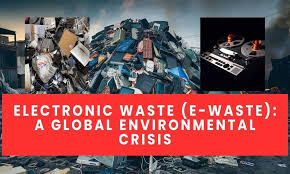
As technology advances and electronic devices proliferate, electronic waste—or e-waste—has emerged as one of the fastest-growing waste streams worldwide. By 2025, the global volume of discarded gadgets, batteries, and components is reaching alarming levels, posing serious environmental, health, and economic challenges.
Let’s explore how e-waste has become a global crisis, its impacts, and the solutions shaping the future.
1. What Is E-Waste?
E-waste refers to discarded electronic devices including smartphones, computers, televisions, and household appliances. Rapid innovation cycles and consumer demand lead to shorter device lifespans and increasing waste.
2. The Scale of the Crisis
- Over 50 million metric tons of e-waste are generated globally each year.
- Only about 20% of e-waste is formally recycled.
- Vast amounts end up in landfills or informal recycling operations, especially in developing countries.
- Toxic substances like lead, mercury, and cadmium contaminate soil, water, and air.
The growing volume and hazardous nature make e-waste a pressing environmental threat.
3. Environmental and Health Impacts
- Improper e-waste disposal releases harmful chemicals affecting ecosystems and biodiversity.
- Workers in informal recycling often face dangerous conditions without protective equipment.
- Communities near dumping sites suffer from air and water pollution-related health problems.
- Wildlife and natural resources are increasingly endangered by toxic contamination.
The human and ecological costs are severe and widespread.
4. Economic and Resource Considerations
- E-waste contains valuable materials like gold, silver, and rare earth metals.
- Recovering these materials reduces the need for mining and conserves natural resources.
- Efficient recycling creates jobs and stimulates circular economy initiatives.
- However, informal sectors often dominate e-waste processing, lacking proper infrastructure.
Formalizing and investing in recycling infrastructure is critical.
5. Global Efforts and Solutions
- International agreements like the Basel Convention aim to regulate e-waste movement.
- Governments and companies promote extended producer responsibility and take-back programs.
- Innovations in modular design and repairability extend device lifespans.
- Public awareness campaigns encourage responsible disposal and recycling.
Collaboration across sectors is vital to tackling the crisis.
Final Thoughts
E-waste is a mounting global crisis with profound environmental, health, and economic implications. Addressing it requires concerted action—from better product design and regulation to responsible consumer behavior and investment in recycling.
By embracing sustainable practices, we can reduce e-waste’s footprint and protect our planet for future generations.
